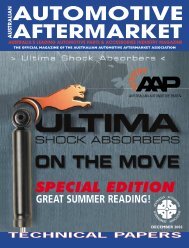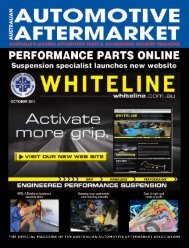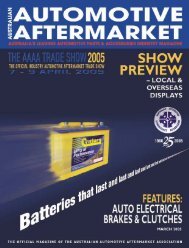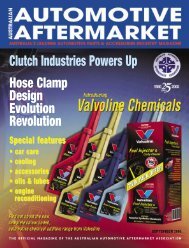AM MAGAZINE SHELL - Australian Automotive Aftermarket Magazine
AM MAGAZINE SHELL - Australian Automotive Aftermarket Magazine
AM MAGAZINE SHELL - Australian Automotive Aftermarket Magazine
- No tags were found...
You also want an ePaper? Increase the reach of your titles
YUMPU automatically turns print PDFs into web optimized ePapers that Google loves.
4WDThe MBS of the strap should be betweentwo and three times the GVM of the lighterof the two vehicles used in the recoveryprocess.Be aware that the recovery strap will beunder greater load if the vehicle is boggedin mud, sand or heavily loaded.If the GVM is not stated on theidentification plate of a vehicle or itsregistration certificate it could be availablefrom the owner’s handbook or from thevehicle manufacturer.Keeping people safeOnly the drivers of the stranded andrecovery vehicle should be in those vehicles.Nobody else should be in or on thosevehicles.Ensure bystanders stay at least 1.5times the un-stretched strap length away, tothe side of the line of recovery.NEVER stand between vehiclesconnected by a recovery strap.Setting up the recoveryAssess the circumstances of thestranded vehicle.If it has bottomed out, clear under thevehicle body so it rests on its wheels.The recovery vehicle should be placed inline (no more than 10 degrees off thestraight line) with the stranded vehicle, foreither a forward or reverse recoveryoperation.The distance between the vehiclesshould be two to three metres less than theunstretched length of the recovery strap.Establish agreed signals between thevehicle drivers, by radio (preferably), handsignals or vehicle horn.Connecting the recovery strapCarefully inspect the recovery strap todetermine that it is in good condition.If the strap is wet, dirty, cut or chafed, itwill not perform properly.A wet strap may be 20 per cent understrength and a damaged strap may break.Do not allow the strap to contact hotsurfaces or sharp edges.Roll the strap out between the vehicles,and make sure there are no twists and leavetwo to three metres of slack between thevehicles.The joining of straps should be avoidedwherever possible - retailers carry varyinglengths of strap.Never use a metal object to join straps.If the strap breaks it can become amissile and causedamage or injury.Check your vehiclehand book for recoverypoint locations, or usecorrectly rated and fittedaftermarket recoverypoints.Do not connect to atow ball or tie downpoint.For any recoverypoint requiring the useof a shackle to attachthe strap, use only loadrated shackles.Only connect to correctly rated recoverypoints on the vehicles, with only ‘LoadRated’ shackles.Load ratings are marked on shackles asWLL.Bow Shackles are suitable for thispurpose and should be rated at least 3.25t.To correctly tighten shackle pins, screwthe pin until it seats, then back off abouthalf to one turn.Over tightening may lead to seized pins,due to the force exerted during recoveryoperations. To reduce the risk of vehicledamage and personal injury, hang a suitablerecovery damper blanket over the recoverystrap about midway to restrict the whippingaction of a strap should it break.The last thing is check all connectionsand clear bystanders to a safe distance (1.5times the un-stretched recovery straplength) to the side of the recovery operationand NEVER in the line of recovery.Making the recoveryBefore the recovery operation driversmust agree on the point to which thestranded vehicle is to be recovered and thesignal (radio, hand signal or horn blast)when that point is reached.With communications maintainedbetween both vehicles, and the recoverystrap secure, the recovery vehicle shouldgently accelerate, taking up the slack andproceeding at no faster than 10-12kph.For best results the stranded vehicleshould be in first gear (or second low), andthe driver should help the recovery by tryingto drive out approximately three secondsfrom when the recovery vehicle moves off.If the vehicle is not recovered on the firstattempt, check under the stranded vehicle,again, for obstacles, reset the slack in therecovery strap and try a little more speed bythe recovery vehicle.Excessive speed or continual jerkingaction while using a recovery strap mayresult in damage to the recovery point,chassis and drive line of both vehicles.When the stranded vehicle reaches theagreed point, the driver should advise andthe recovery vehicle should stop and thenthe stranded vehicle should stop.Where the proper use of a recovery strapis unsuccessful, use an appropriate sizedrecovery winch.Do not attempt to remove the strap untilboth vehicles are stationary and secured.Recovery straps require rest periodsbetween use to return to their originallength and capacity. Excessive pulls over ashort period of time can cause heat buildup and possible failure.General care and maintenanceNever allow your strap to rub againstsharp or hot surfaces.Avoid twists and kinks after washing andwhen dry, always coil your strap for storage.Clean your strap with warm water and amild detergent, allowing thorough dryingbefore storage.Foreign material such as sand and gritcan permanently damage the strap fibres.Check full length of straps for nicks andcuts before and after use.If damaged, replace it.Never use the strap as a lifting sling.Inspect shackles for damage.If the pins are hard to turn then theshackle has been overstressed so it must bereplaced.CAUTION: Always follow the recoverystrap guidelines for safe useCompiled by the <strong>Australian</strong> 4WD IndustryCouncil in conjunction with the 4WDIndustry to assist the safe use ofrecovery strapsAU T O M O T I V E A F T E R M A R K E T M AG A Z I N E AU G U ST 2 0 0 8 61
















